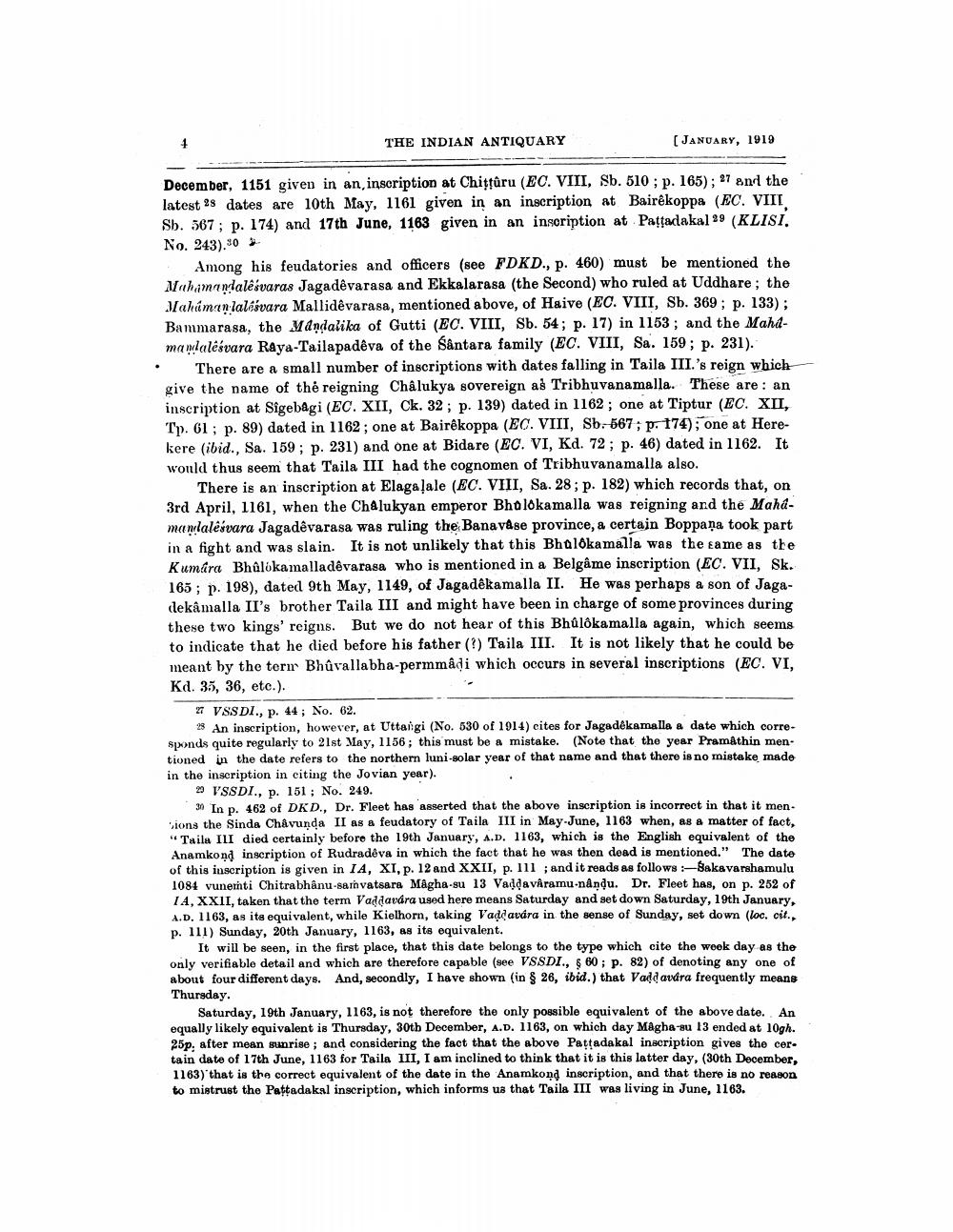________________
THE INDIAN ANTIQUARY
(JANUARY, 1919
December, 1151 given in an inscription at Chittûru (EC. VIII, Sb. 510 ; p. 165): 27 and the latest 28 dates are 10th May, 1161 given in an inscription at Bairêkoppa (EC. VIII Sb. 567; p. 174) and 17th June, 1163 given in an inscription at Pataclakal 39 (KLISI. No. 243).30 >
Among his feudatories and officers (see FDKD., p. 460) must be mentioned the Mahamandalesvaras Jagadêvarasa and Ekkalarasa (the Second) who ruled at Uddhare; the Mahámanlalásvara Mallidêvarasa, mentioned above, of Haive (EC. VIII, Sb. 369; p. 133): Bammarasa, the Mandalika of Gutti (EC. VIII, Sb. 54; p. 17) in 1153 ; and the Mahdmamlaleśvara Raya-Tailapadêva of the Sântara family (EC. VIII, Sa. 159; p. 231).
There are a small number of inscriptions with dates falling in Taila III.'s reign which give the name of the reigning Chalukya sovereign as Tribhuvanamalla. These are: an inscription at Sigebægi (EC. XII, Ck. 32; p. 139) dated in 1162; one at Tiptur (EC. XII, Tp. 61; p. 89) dated in 1162; one at Bairêkoppa (EC. VIII, Sb.567; p. 174); one at Herekere (ibid., Sa. 159; p. 231) and one at Bidare (EC. VI, Kd. 72; p. 46) dated in 1162. It would thus seem that Taila III had the cognomen of Tribhuvanamalla also.
There is an inscription at Elagaļale (EC. VIII, Sa. 28; p. 182) which records that, on 3rd April, 1161, when the Chalukyan emperor Bholokamalla was reigning and the Mahamanilalesvara Jagadêvarasa was ruling the Banavase province, a certain Boppaņa took part in a fight and was slain. It is not unlikely that this Bhalokamalla was the same as the Kumara Bhâlókamalladêvarasa who is mentioned in a Belgâme inscription (EC. VII, Sk. 165 ; p. 198), dated 9th May, 1149, of Jagadêkamalla II. He was perhaps a son of Jagadekâ malla II's brother Taila III and might have been in charge of some provinces during these two kings' reigns. But we do not hear of this Bhålôkamalla again, which seems to indicate that he died before his father (?) Taila III. It is not likely that he could be meant by the terr Bhûvallabha-permmadi which occurs in several inscriptions (EC. VI, Kd. 35, 36, etc.).
27 VSSDI., p. 44; No. 62.
* An inscription, however, at Uttangi (No. 530 of 1914) cites for Jagadékamalla a date which corresponds quite regularly to 21st May, 1156; this must be a mistake. (Note that the year Pramåthin mentioned in the date refers to the northern luni-solar year of that name and that there is no mistake made in the inscription in citing the Jovian year).
23 VSSDI., p. 151 ; No. 249.
30 In p. 462 of DKD., Dr. Fleet has asserted that the above inscription is incorrect in that it men. biona the Sinda Chávunda II as a feudatory of Taila III in May June, 1163 when, as a matter of fact,
Taila III died certainly before the 19th January, A.D. 1163, which is the English equivalent of the Anamkond inscription of Rudradeva in which the fact that he was then dead is mentioned." The date of this inscription is given in IA, XI, p. 12 and XXII, p. 111 ; and it reads as follows Bakavarshamulu 1084 vunetti Chitrabhânu-samvatsara Magha-su 13 Vadda vAramu-nanļu. Dr. Fleet has, on p. 252 of IA, XXII, taken that the term Vaddavdra used here means Saturday and set down Saturday, 19th January, A.D. 1163, as its equivalent, while Kielhor, taking Vad avdra in the sense of Sunday, set down (loc. cit., p. 111) Sunday, 20th January, 1163, as its equivalent.
It will be seen, in the first place, that this date belongs to the type which cite the wook day as the only verifiable detail and which are therefore capable (see VSSDI., $ 60; p. 82) of denoting any one of about four different days. And, secondly, I have shown (in 26, ibid.) that Valdavára frequently means Thursday.
Saturday, 19th January, 1163, is not therefore the only possible equivalent of the above date. An equally likely equivalent is Thursday, 30th December, A.D. 1163, on which day Magha-su 13 ended at 10gh. 25p, after mean sunrise ; and considering the fact that the above Papadakal inscription gives the cer. tain dato of 17th June, 1163 for Taila III, I am inclined to think that it is this latter day, (30th December, 1163) that is the correct equivalent of the date in the Anamkond inscription, and that there is no reason to mistrust the Pattadakal inscription, which informs us that Taila III was living in June, 1163.




